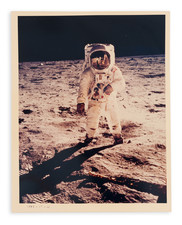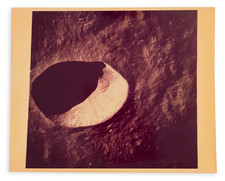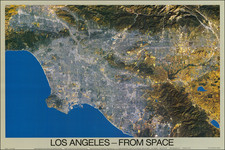The Final Lunar Landing Mission
This photograph, AS17-134-20425, taken on December 11, 1972, showcases scientist-astronaut Harrison H. Schmitt, the lunar module pilot, diligently collecting lunar rake samples at Station 1 during the first Apollo 17 Extravehicular Activity (EVA-1) at the Taurus-Littrow landing site. The image was captured by astronaut Eugene Cernan, the mission commander. The lunar rake, a specialized Apollo lunar geology hand tool, is employed to gather distinct samples of rocks and rock chips, ranging in size from one-half inch (1.3 centimeters) to one inch (2.5 centimeters). Schmitt's focused efforts in this photograph reflect the importance of collecting valuable geological samples to advance our understanding of the Moon's composition and history.
Apollo 17, launched on December 7, 1972, was the final mission of NASA's Apollo program and marked the last time humans set foot on the moon. Led by Commander Eugene Cernan, Lunar Module Pilot Harrison Schmitt, and Command Module Pilot Ronald Evans, the mission showcased a series of scientific experiments and discoveries. Cernan and Schmitt spent over three days on the lunar surface, conducting three extravehicular activities (EVAs) that involved collecting lunar samples, deploying various scientific instruments, and exploring the Taurus-Littrow valley. Meanwhile, Evans orbited the moon, conducting photographic and geological observations. Apollo 17 not only set records for the longest lunar landing and longest total time spent on the moon's surface, but it also signified the end of an era in human space exploration and the Apollo program's lasting legacy.











![(San Diego -- WWI Panoramic Photograph) Camp Kearny. Co. M. 158th Infantry [World War I panoramic group portrait of U.S. Army Infantryman at Camp Kearny, San Diego]](https://storage.googleapis.com/raremaps/img/small/91707.jpg)

![(Photographs of Western Logging) [Three cabinet card albumen photographs of loggers at work, felled trees]](https://storage.googleapis.com/raremaps/img/small/87452.jpg)
![(California - 19th-Century Photographs) [Album of 33 photographs of California, Oregon, and Washington, including Yosemite Valley, Stanford University, Sutro Heights in San Francisco; Mt. Hood; Mt. St. Helens; Portland, Oregon]](https://storage.googleapis.com/raremaps/img/small/94083.jpg)

